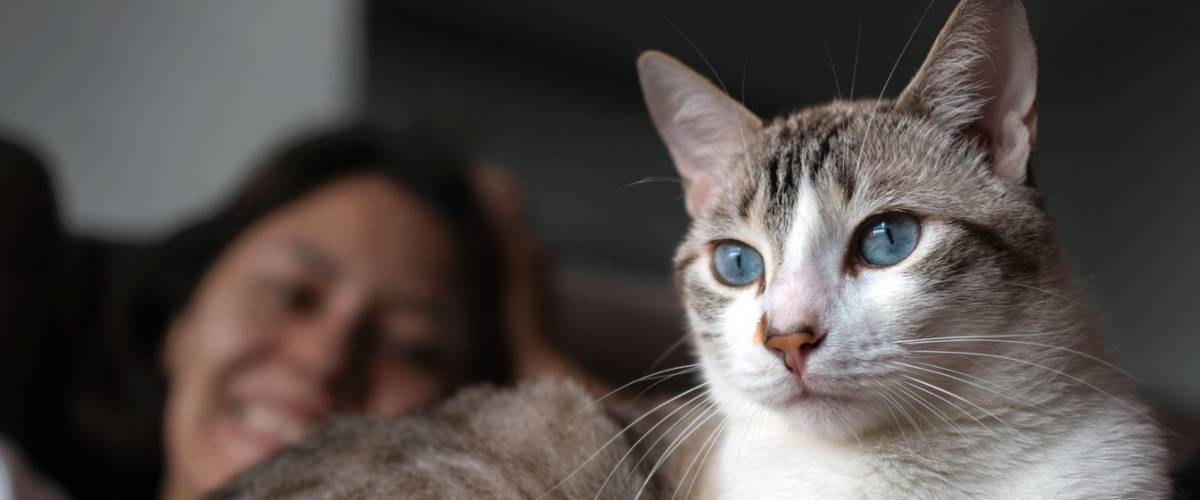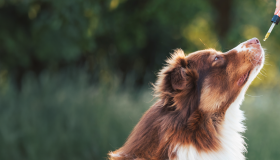
December 8, 2022 — Dr. Kelly Diehl discusses MRSA and pets with Dr. Meghan Davis of Johns Hopkins University. The pair talk about Dr. Davis’s research on how MRSA, people and pets intersect, and they discuss steps pet parents can take to keep their pets – and themselves – safe.
Resources:
https://www.thelancet.com/journals/laninf/article/PIIS1473-3099(12)70156-1/fulltext
0:00:00.9 Kelly Diehl: Hi, this is Dr. Kelly Diehl. The broadcast you're about to listen to was originally scheduled to be episode 49 of our Fresh Scoop Podcast. However, we decided to reshuffle our episodes slightly and it is now episode 51. We hope you enjoy this wonderful interview with Dr. Meghan Davis. Well, on to the show.
[music]
0:00:36.1 KD: Welcome to Fresh Scoop episode 49. Pets, people, MRSA, and multi-drug resistance, oh my. I'm your host, Dr. Kelly Diehl, Morris Animal Foundation, Senior Director of Science and Communication. And today we'll talk to Dr. Meghan Davis. Dr. Davis is Associate Professor and Doctoral Program Director of Environmental Health and Engineering at Johns Hopkins Bloomberg School of Public Health. Welcome, Meghan.
0:01:06.9 Meghan Davis: Thanks. It's great to be here.
0:01:08.9 KD: Before we get started, tell us a little bit about yourself, why it led you to become first a veterinarian and then move into your current position.
0:01:18.9 MD: Yeah, absolutely. I was one of those kids who decided I wanted to be a veterinarian when I was 10 years old and I never changed my mind. But when I got to college, I became aware of public health. And so, I decided to kind of smush those two together. And so, my entire career, I've wanted to do veterinary public health and One Health. I went to vet school in the late '90s and really focused a lot on government and public health and population-based approaches that really looked at the intersection of humans, animals, and the environment. And then I had intended to go directly into a PhD program and go into research right away. But I got to clinic and I realized not only did I need to ride this bike a little bit if I was ever to ride it again in the future, but that I enjoyed practice more than I thought I would. So, I ended up being a rural veterinarian for the first years of my practice. I did dairy mixed. And so, I worked with Amish and Mennonite dairy farmers in Southeast Central Pennsylvania. It was a fantastic experience. And then I needed to maybe pay off those loans a little bit more than I was doing at the time as a rural vet with a rural vet salary.
0:02:42.7 MD: So, I switched to an AAHA certified small animal exotics practice and then eventually came back to my original plan, which was to really be an academic doing One Health research. And so I got my MPH and my PhD from Johns Hopkins Bloomberg School of Public Health. And then just stuck around. So, I came on to faculty. I guess, it's almost a decade ago now that I stepped onto faculty in environmental health and engineering.
0:03:11.9 KD: Wow, that's great. And I think you shared with me and correct me if I'm wrong. I think you're the first veterinarian. Is that true in that group or one of just a few folks?
0:03:24.4 MD: Yes. So there have been other veterinarians at Johns Hopkins, and Johns Hopkins is actually pretty well known for some very well-established residency programs in pathology and laboratory animal medicine. And so those people who look at slides or who perform post-mortems and are able to tell you why and to really kind of explain in terms of what's happening at the cellular level or within the organ system. What's going wrong. That's the kind of training program that we have here. And so, we've trained lots of veterinarians and veterinary students come through. And I've even had Morris Animal Foundation veterinary student scholars come through and do research with our group. But I am one of the I would say, very few as a primary appointment in the School of Public Health. And so, I do a lot of work with my great colleagues. We call it across the street because the School of Medicine and the School of Public Health are separated by a street. But certainly do a lot of collegial activities together.
0:04:33.8 KD: Great. Well, thanks. And thanks for sharing that, Meghan. I think that's really awesome. I feel like veterinarians are becoming more common team member in areas where we traditionally think maybe of MDs. And I think that's a really positive development. Moving into today's lecture. For everyone listening, I didn't have to arm twist Meghan, but I was really glad to ask her to come on to talk about something that I think it can be really confusing for people and there's a lot of information out there. And it's about MRSA. And I think everyone's heard that acronym MRSA. But Meghan, this is your area of expertise. So, tell us a little bit about what is MRSA exactly and how it's transmitted? Maybe let's start with people.
0:05:29.5 MD: Sure. So, MRSA stands for methicillin-resistant Staphylococcus aureus. And you might think, well, what's so great about methicillin-resistant that we care only about that. And it actually began when we started to see drug resistance in Staph originally. We were using a lot of penicillin and then we started to see penicillin-resistant strains. This is primarily in human health care. And so, then methicillin was released. And so, methicillin-resistant followed suit as you might expect. And methicillin-resistant Staph aureus has stuck as kind of the moniker that we use.
0:06:11.0 MD: Typically, the strains that are resistant to methicillin aren't just resistant to the penicillins. They're also resistant to cephalosporins. And this means that they're resistant to many of the drugs that we would prefer to use as a first line of treatment if someone comes in and has a skin or soft tissue infection. So, you think of like a boil or a pus pocket and maybe getting worse and not going away. That's the kind of thing that MRSA causes in people in the community. It can actually get worse and people can have septicemia. They can die from MRSA infections, lose limbs in maybe less severe circumstances.
0:06:57.6 MD: And then there are of course, worse scenarios in the hospital where people might have had a surgery and then get a surgical site infection. And so, all of these are very concerning, not only because of the pain that goes with it and the burden of having to go through treatment, but because methicillin-resistant Staph aureus is drug resistant. You have to go to next line antibiotics in order to treat it. And then some of those may be second choices for a lot of reasons. They may be second choices because we're trying to preserve them for these uses, or they may be second choices in part because they have some side effects that aren't as good. And they can often be more costly in terms of treatment. And that whole process of going through with a drug-resistant strain usually means that people are under treatment longer. They may be in the hospital longer. They may have more severe outcomes. And I'm talking about this from the human perspective, but the same is true on the veterinary side. So, if you have an animal who has a drug-resistant infection, then they can also have more severe outcomes, longer courses of treatment, more expensive treatment, et cetera.
0:08:14.1 MD: And we worry too, because from the sort of context of One Health, where we're thinking about One Medicine, how we treat animals and how we treat humans. And then when we think about it from a One Health perspective, we're engaging with shared environments. So now you're thinking about this maybe at the household level. And if you have a person undergoing antibiotic treatment, or if you have an animal undergoing antibiotic treatment, you now have those strains that might be undergoing that what we call selective pressure within the home. And so what selective pressure is, is you take an antibiotic and you apply it to a system - that could be a person that could be an animal, that could be a surface in the home. And now you're killing off all of the susceptible members of that community of bacteria. And you are enriching for and allowing to grow the ones that are resistant. So, for example, if I had two different strains of Staph aureus in my nose, and one of them was 90% of what was in my nose, and one of them was 10% of what was in my nose. And what was 90% were all susceptible, and that 10% were resistant.
0:09:28.8 MD: If I then went on an antibiotic that the resistant group could evade, suddenly it wouldn't be 90% susceptible and 10% resistant. I would denude, I would kill off a lot of the susceptible bacteria. And then suddenly I'd have maybe 90% resistant bacteria in my nose. Which means that if I would then get a cut or have some other compromise, that these are the bacteria that are hanging out and are more likely to cause the infection if I give them the opportunity or if there's something else that allows them to kind of set in and create an infection.
0:10:13.5 KD: All right. Yeah, I think that's really important. And I appreciate you telling us about it. I am... As I'm thinking for my... As I'm thinking about my next question, I'm going to paint a scenario that I had, this is real life in practice, I had a dog that I was seeing, and it had a multitude of problems. But as a gastroenterologist, most of what I was dealing with was recurrent large bowel diarrhea and food allergies. And one day the owner comes in with these big bandages on her legs, and she goes, Kelly, I have to tell you, I have MRSA. Which first of all made me nervous. And then we were trying to have this discussion about her dog, who was probably a little immunocompromised because we had a little steroid on there to try to control the chronic enteropathy. Tell us a little bit about... because I was at a loss in some ways to deal with my client. We were okay, but I think ultimately, but tell us about MRSA and pets, because I think that comes up a lot.
0:11:22.6 MD: Yeah, it is one of the big challenges that clinicians face. And there are recommendations that we have put together from the World Veterinary Dermatology Conference. So... I'm sorry, Congress. And so I would say that it's kind of good news, bad news. So, the bad news is that, yes, pets can get MRSA. The good news is that they tend not to do so very often. We struggle more in veterinary dermatology with Staph pseudintermedius and Staph schleiferi. These are like kissing cousins to Staph aureus. So, they have their own kind of concurrent set of problems that we deal with all the time. They tend to get more drug-resistant, especially once you get to a vet hospital or a tertiary care setting. They've been through all of the frontline treatments. And now you've got multidrug resistance strains, and they can be incredibly intractable in some of the exact same ways in which MRSA can be really intractable for people. But it is possible for pets to carry MRSA and to get sick from MRSA. It just doesn't happen as often. So actually, in the study that you and I have been talking about before I came on today. This was a study that we did with the University of Pennsylvania, where they were very interested in whether for people, you could, instead of just treating the individual patient, you could treat the patient who had MRSA, and then also do a decolonization intervention in people in the household.
0:13:12.0 MD: So, every single household member undergoing a chlorhexidine body wash and nasal mupirocin for a short period. We're talking like one to two weeks, trying to harmonize all of that. And so we have baseline before anyone was randomized to that. And then we had a follow up three months later. We enrolled all the pets in the home where there were pets, and people consented. So ,it was over 200 pets. And out of that entire group, we only had like a nine or 10% MRSA positivity rate in the pets. Every single one of these pets was exposed to MRSA. And so this is a highly exposed population. And yet we only had nine or 10%. And most of these were carriage. Out of that entire group, there was only one MRSA infection that we identified over the three months of follow up. Obviously, we lost a few to follow up. But we were able to really follow quite a few over 100. And this one was a dog that underwent surgery. And it underwent surgery like just a couple days after the baseline visit. And interestingly, the only place in the house that we had found to be MRSA positive that people were negative. All the environment sites that we sampled, such as the pillow on the bed of the people who were the owners, such as the handle on the refrigerator, such as the top of the television, all of these human focus sites were negative, the dog's bed was positive.
0:14:50.4 MD: And then it ultimately matched the isolate that the dog ended up having. And so I think that's a little bit reassuring that the risk in terms of infection for pets is smaller, it's nonzero. And the scenario you've presented is one where you do have an immunocompromised pet. So, some of the recommendations are not necessarily to treat the pet with antibiotics. We all know that especially with the GI case, sometimes the last thing you want to do is denude the entirety of their normal native flora. If you take away that microbial ecology of their GI tract, you can actually cause a lot of disruption. And then that can open up for other kinds of infections like Clostridioides difficile. So, C. diff, big, big problem. So instead, we recommend that especially in those kinds of cases that you think about contact isolation. And so this would potentially be as simple as while the person's undergoing treatment to have them not be the one to feed the pets and to keep them out of the bedroom. Maybe if needed, you put the pup in a crate or the kitty in a big giant cat crate, just for that period of time.
0:16:06.7 MD: Not to necessarily have to get them out of the house, but also to think about, maybe the environment does need to be addressed. And that's one of the things that we're starting to see in other kinds of work that we're doing related to drug resistance is the potential for the environment to be an important reservoir for both people and pets. And this may be true, not just for MRSA, but for other infections as well. Staph aureus, Staph pseudintermedius, Staph schleiferi are remarkably good at sticking around in the environment and they can last in the environment for weeks or months.
0:16:47.3 KD: Wow. Wow.
0:16:48.4 MD: And so this means that when you're facing cases that are particularly intractable, that it may be important to start thinking about an environmental intervention. Some sort of cleaning, certainly laundering of the pet bed, laundering of the sheets for the person who's the owner and staying on top of making sure that surfaces are cleaned routinely. There are a couple of caveats there. I don't think it's something that will 100% work in all cases, but it is something that I think when you're struggling clinically with certain cases, it's very important to consider.
0:17:26.2 KD: And that... Thanks for that big... that explanation. And I think that was also a lovely summary of the paper, as you mentioned, that we were just discussing. I know this is big, but talk a little bit more about your kind of overall research focus and you alluded to it, but talk again a little bit more about why it's important and why you kind of do a lot of work on pets and MRSA and people?
0:17:57.2 MD: Absolutely. So, we're actually very interested in the microbiome as well. So, we're interested in how our potentially good commensal flora and pathogens can interact with each other and how all of these can be transmitted among humans, animals and the environment. We tend to spend a lot of time in households and especially for pets, they might spend the entirety or nearly the entirety of their lives within the home. And you also have other very important members of the family, like kids may spend a lot of time in the home and they may share a lot of interactions either directly or through surfaces. And so if we're thinking about ways to optimize the benefits from human animal interactions. So, there are a lot of benefits. We get these mental health and wellbeing benefits. There are benefits to physical health and some microbial exchange might be quite good. We understand that from the literature that's really looking at allergy and other allergic diseases like asthma, that very early life pet ownership is incredibly, it's protective. So, dogs and cats in different studies have been found to be associated with lower rates of development of allergic disease as the kids get older. So, all of these are big, big pluses.
0:19:22.8 MD: What we don't like to do though is use antibiotics. And so we're starting to see that early life antibiotics use cannot be associated with worse risk for allergic disease development. And we have the concerns that we've already talked about with regard to drug-resistant strains and having to go to drugs that may have more side effects. Certainly, going through multiple courses of antibiotics is going to further denude that natural microbial community that you have. And that's not just within the gut. We have skin microflora, we have microflora in our upper respiratory tract, et cetera. And so what we want to try to do is prevent as much as possible the need to go into these very invasive antibiotic treatments. That are going to disrupt the local flora. And so what we've been focused on in a lot of our work is how do you think about holistically treating and thinking about the entire household? So that if you have, for example, a person like your client who had a MRSA infection. How would you then prevent the need for further use of antibiotics in the household by making sure that you're reducing the risk for the pet to acquire MRSA or another, you're basically to have exposure to drug resistant pathogens through the owner. Where that drug resistance could even potentially be exchanged between human flora and dog flora.
0:21:02.6 MD: So that we might have a MRSA strain that could exchange genetic information with a Staph pseudintermedius strain and that that could have some impacts on the dog's health long-term as well. So in thinking about this, we're trying to look at ways that we can intervene as early as possible and in as much of a preventative way as possible. And so that's kind of the overarching goal of the work that we've been doing.
0:21:33.6 KD: Which is really, really fascinating. And I want to turn back the clock a little bit because we've talked about this indirectly, which was your original foundation grant and a wonderful article in The Lancet, which is for those of... It's kind of right... The sort of British version of the New England Journal of Medicine.
0:21:55.1 MD: I don't think Lancet would... Yes, they're out of the UK. I'm not sure that they would.
0:22:02.5 KD: Yeah, they would probably not like it, you're right. But it's... And it's been around like over...
0:22:08.6 MD: Long time.
0:22:08.9 KD: Almost 200 years, I think. But it's a great, very well-respected journal. And it was... It's a really fun article. And I will put it in... A link to it in our show notes for anyone interested, because it's wonderful. You have great illustrations and everything in it. But tell us a little bit about that study and what you were measuring and your methodology, basically.
0:22:31.8 MD: Yeah, so The Lancet paper is, Lancet Infectious Diseases is a review article that really set the stage for the PET study, the one that I talked about that was in collaboration with the University of Pennsylvania and their randomized controlled trial of people. And we went in and we were looking at the pets and the environment. And the methodology of this as a nested sub study that derived the randomization assignment from the human side of the randomized controlled trial of the household wide decolonization intervention. And so what this led us really be able to do was not only do a nice cross sectional analysis at baseline of risk factors associated with different things. And so the most recent paper was looking at multidrug resistance within various Staph strains that we identified from pets and looking at what the risk factors were associated with multidrug resistance. And we looked at the Staph aureus separately from other coagulase-positive Staph and really identified that the environment was a very, very important feature for the Staph aureus. And we've done other work that's looked at the environmental strains. And one of the concerning things that we found in that study, which was published a number of years ago now, was that uses of disinfectants in the household was somewhat associated with multidrug resistance.
0:24:06.8 MD: And some other students within this larger project were able to identify some genes associated with chlorhexidine resistance within some of these isolates. So even our use of disinfectants can be like the antibiotics. Something you have to do sometimes, but it can be associated with selective pressure. And so that's something that we really want to follow up on in order to be able to sort of best make recommendations to people about what products might work better over the longer term. We've also been looking at additional pieces related to risk factors for the pets to get MRSA and have done some work, as I said, related to that case that we had with the surgical site infection. Where we were able to do whole genome sequencing of the isolates from the environment and the surgical site infection in order to really kind of draw that bright line between the dog's bed and the dog's surgical site infection. So that's the larger study. And then we also have been able to then use the randomization of the household so that the people were undergoing treatment, but the environment and the pets were not, to kind of help tease out what roles we might see from pets in the environment and really showing that environmental contamination within the homes might not be good for people either.
0:25:39.9 KD: Right. What are some of the... I mean, you're a really busy person. You've got a lot going on. You talked... You told us a lot of information, but what are some remaining, like just big unanswered questions that you're pursuing or that we... Are in your mind as like, these are things we need to answer.
0:26:02.3 MD: Yeah. I think the biggest thing that we need to answer is how do we intervene in the environment to address the health of people and pets. So, what are the things that we can do within the environment as it relates to MRSA infection, as it relates to other kinds of infections, that will help prevent transmission within the home between pets and people, and that will help protect both pets and people from re-exposure over time. And so that's the big challenge with community MRSA. What you tend to see is that it will kind of appear like popcorn. You'll have a case in a household and then six months later, you might have another case either in the same person or a different person in the household. And so how do you kind of stop that chain? And it's something that, we worry about too with Staph pseudintermedius and Staph schleiferi with animals. And so maybe we need to take more household-wide approaches and think about what we can do in the environment. But right now we don't have enough research on the environmental piece to really be able to make strong recommendations.
0:27:13.2 KD: And it seems like that is a fine edge. Because you have just talked about the use of disinfectants in the household, selecting for resistance, but at the same time, the environment, I think, as you pointed out, is potentially an important source for reinfection.
0:27:35.7 MD: Exactly. And so this brings us to some things that we know work in human healthcare settings. For example, laundering. If you have contaminated bedding within a hospital and you put it through laundering, then you can really reduce that contamination. The same thing with scrubs. We certainly see that laundering of bedsheets can be really important. And so doing that more frequently may be one strategy that people can use.
0:28:02.3 KD: Oh, great. So, there are other things other than using a lot of disinfectants, it sounds like, in the home. So, Meghan, we're running... Kind of running out of time, but what would be your take home messages for our listeners about this really important, kind of hot topic?
0:28:22.9 MD: Absolutely. Well, a) keep your pets. If there is MRSA in the home, there are many strategies that can be employed. And really, it's the same kind of thing that we think about with COVID. Keep your pets but keep your distance if you have COVID. Same thing for MRSA. Keep your pets, just keep your distance if you have MRSA. And that goes both ways. So, if we as veterinarians, have patients, our pet animals in homes, that might have an infection that could be transmitted, then humans need to use some precautions too. Washing of hands, some distancing, et cetera. I think it's been really interesting with the COVID-19 pandemic How much more fluent we've all become with some of these strategies is that are really meant to limit transmission. You know, distancing, use of personal protective equipment. And so in many cases, it's not like you necessarily need to wear an N95 mask around your pet if you have MRSA. But washing your hands or using gloves when handling, like if you're the sole owner, and there's no one else who can take care of the pet, then if you are washing your hands before handling their food, if you are keeping your distance, then these are things that you can do in order to help prevent transmission. In addition to all of the environmental control strategies we've chatted about.
0:29:48.7 KD: Oh, great. Well, thanks so much, Meghan. That does it for this episode. I can't believe that just flew by. And once again, thanks to Dr. Meghan Davis for joining us. We'll be back with another episode, obviously, next month that we hope you'll find just as informative. We know the science of animal health is ever changing and all of us need cutting edge research information to give our pets and our patients the best possible care. And that's of course, why we're here. You can find us on iTunes, Spotify, Google Podcasts and Stitcher. And if you like today's episode, we'd sure appreciate it if you could take a moment to rate us. That will help others find our podcast. And of course, to learn more about Morris Animal Foundation's work, go to morrisAnimalFoundation.org. There you'll see just how we bridge science and resources to advance the health of animals. You can also follow us on Facebook, Twitter and Instagram. I'm Dr. Kelly Diehl and we'll talk soon.




